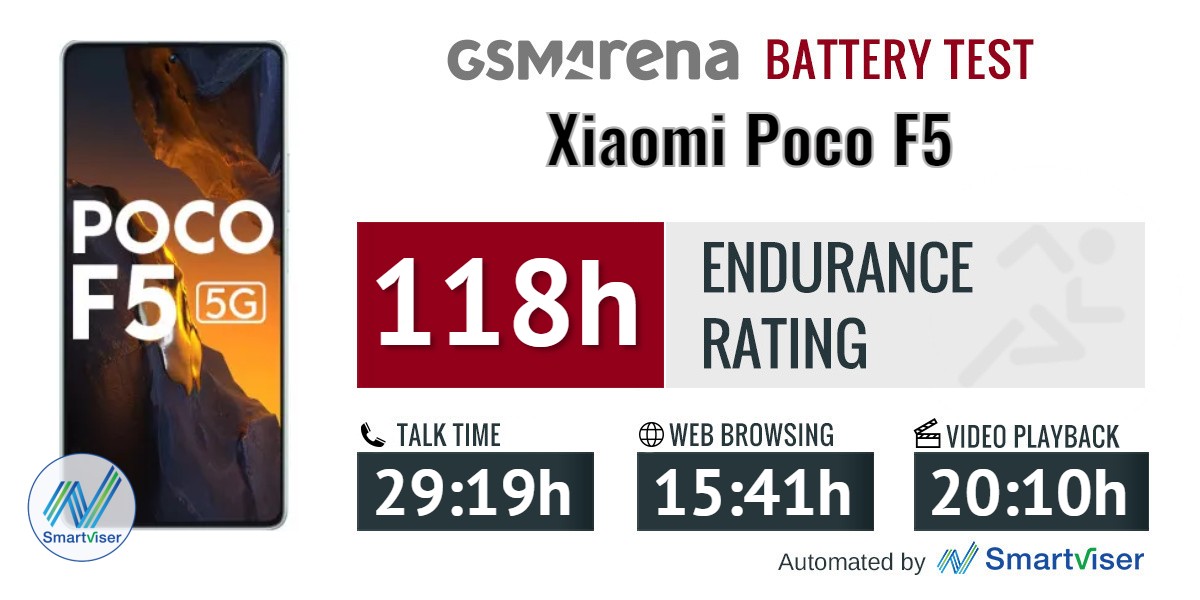Introduction and specs
The F5 and the F5 Pro are almost identical in size and core features, but upon closer look at the specs sheet, we start to see how they differ in some niche aspects. Still, both phones are aimed towards the budget-conscious crowd, with the F5 Pro acting as an affordable flagship.


Xiaomi Poco F5 • Xiaomi Redmi Note 12 Turbo
The subject of this review, however, is the vanilla Poco F5 and it's important to note that the F5 carries a different name in some markets - Xiaomi Redmi Note 12 Turbo. The latter was released back in March, so you can use this review as a reference if you are deciding on buying the Redmi Note 12 Turbo, as we doubt we'd get hold of a review unit for that one any time soon./p> 
The handset offers a few notable upgrades over its predecessor while maintaining the same price point (the F4 launched for €400). It's a great choice if you are looking for a capable midranger with some upper-tier features on the side.
Xiaomi Poco F5 specs at a glance:
- Body: 161.1x75.0x7.9mm, 181g; Gorilla Glas 5 front, plastic back and frame; IP53, dust and splash resistant.
- Display: 6.67" AMOLED, 68B colors, Dolby Vision, HDR10+, 120Hz, 500 nits (typ), 1000 nits (peak), 1080x2400px resolution, 20:9 aspect ratio, 395ppi.
- Chipset: Qualcomm SM7475-AB Snapdragon 7+ Gen 2 (4 nm): Octa-core (1x2.91 GHz Cortex-A710 & 3x2.49 GHz Cortex-A710 & 4x1.8 GHz Cortex-A510); Adreno 725.
- Memory: 256GB 8GB RAM, 256GB 12GB RAM; UFS 3.1.
- OS/Software: Android 13, MIUI 14 for POCO.
- Rear camera: Wide (main): 64 MP, f/1.8, 1/2", 0.7µm, PDAF, OIS; Ultra wide angle: 8 MP, f/2.2, 120˚, 1/4", 1.12µm; Macro: 2 MP, f/2.4.
- Front camera: 16 MP, f/2.5, (wide).
- Video capture: Rear camera: 4K@30fps, 1080p@30/60/120fps, gyro-EIS; Front camera: 1080p@30/60fps.
- Battery: 5000mAh; 67W wired, PD3, QC4, 100% in 46 min (advertised).
- Connectivity: 5G; Dual SIM; Wi-Fi 6; BT 5.3; NFC; Infrared port; 3.5mm jack.
- Misc: Fingerprint reader (side-mounted); stereo speakers.
The standard F5 runs on a brand new Snapdragon 7+ Gen 2 chipset, which hopefully isn't just a rebranded Snapdragon 778G yet again. The handset also features a familiar 6.67-inch OLED panel with a 120Hz refresh rate and high maximum brightness as its more expensive sibling but at a lower resolution. The camera setups of both devices are identical, and the battery capacity is rated at around 5,000 mAh with support for blazing-fast 67W fast charging. The only difference is that the F5 Pro adds wireless charging to its list of features.

It seems like no matter which device you decide to get, the user experience won't vary by much. But if wireless charging and a more future-proof SoC, such as the Snapdragon 8+ Gen 1, are up on your priority list, the few extra bucks for the F5 Pro might be worth it. Still, we believe that the F5 will get you 90% of where you want to be, making it presumably the better deal of the two.
Unboxing the Xiaomi Poco F5
The handset comes in a standard retail box containing all the usual user manuals, the appropriate 67W fast charger and a USB-A to USB-C cable for data transfer and charging.

There's also a transparent silicone case as a bonus, so it doesn't conceal the neat paint job.
Design and ergonomics
You could say that Xiaomi went for something more catchy with this year's Poco F5. Or at least that's what we see with the White color variant. A shimmery pattern on the back changes like a hologram under the right angle and transitions into icy blue toward the bottom half of the device. It looks nice. But if it's too tacky for you, the other two color options are more formal, so there's something for everyone.

The first thing we noticed about the Poco F5, however, is how light it is. At just 181 grams, the F5 offers a significantly lighter chassis than its predecessor, albeit slightly thicker at 7.9mm. Either way, the F5 is quite comfortable to hold, and the gentle curve on the back makes it a tad more comfortable, while the flat frame helps for a grip more secure.

We also like how Xiaomi went for individual camera rings instead of a whole camera island piece. It looks fresh and different. Also, the camera lenses stick out just a little, so there's no excessive wobbling when placing the F5 on a flat surface.

Going back to the side frame, which, just like the back panel, is made of plastic with a matte finish instead of gloss. It's almost completely flat, except for the slightly rounded edges that meet with the back and front panels. The left side is completely clean, so you will find the volume rocker on the right, along with the power button that doubles as a fingerprint reader.
The bottom is home to the USB-C connector, loudspeaker grille and the SIM card tray, which doesn't have room for a microSD card. At least the top accommodates a 3.5mm audio jack along with the second speaker grille and an IR blaster.

The front is business as usual, and yet, we are impressed with the thin bezels and excellent craftsmanship. The side bezels look ever so slightly thinner than the top and bottom ones. Symmetry seems to have been a priority for the designers. The device looks premium, even from up close - the cutout for the selfie camera is small and unobtrusive, while the edges of the display seamlessly transition into the side frame without creating any unpleasant ridges or protrusions. Of course, the panel is protected by Gorilla Glass 5.

Overall, we really liked the design - it's simple, ergonomic, discreet and lightweight. There's really nothing bad to say about it. And for the asking price, the IP53 certification against dust and splashes is a nice bonus.
Bright 6.67-inch OLED
The new Poco F5 uses the same 6.67-inch OLED panel as its predecessor, and that's actually good news. The display features 1080 x 2400px resolution, 12-bit color depth, 120Hz refresh rate and 240Hz touch sampling rate for more responsive operation during gameplay. The panel is also marketed as eye-friendly as it uses high-frequency 1920Hz PWM for less eye strain and is SGS Low Blue Light-certified. But more importantly, the panel supports HDR10+ and Dolby Vision content, so you can enjoy your Netflix, Amazon Prime and YouTube shows and videos in the highest possible quality.

The display scored excellently in all of our tests too. In manual mode, the panel peaked at 470 nits, while in auto mode, it was able to reach 963 nits. Those values are pretty close to the advertised 500 and 1,000 nits, respectively. Interestingly, they are slightly lower than last year's Poco F4, but the difference is rather negligible.
Color accuracy is also great with just 1.1 average dE2000, but in the so-called "Standard" color preset. In the default color mode, the display reproduces blue-ish whites and grays pushing the average dE2000 above 4.0.
HRR control
MIUI 14 offers three refresh rate modes - 60Hz, 120Hz and Default, which is automatic. The latter dials down to 60Hz when necessary - when the screen is idle or when watching videos/movies in the Gallery app, YouTube, Netflix, etc. In all other cases, the panel would switch back to 120Hz for smoother operation. The HRR control is nothing too fancy, and it gets the job done to save some precious battery. And if you are having any compatibility issues with apps, you can always try to force 120 or 60Hz refresh rate as the system allows you to adjust that on per app basis.
Battery life
The Poco F5 now packs a bigger 5,000 mAh battery compared to its predecessor with a 4,500 mAh-rated cell and supposedly more energy-efficient chipset. The Poco F5 managed to hit 118h overall battery score with excellent screen-on runtimes and standby. The video playback endurance, however, is particularly impressive.

Our battery tests were automated thanks to SmartViser, using its viSerDevice app. The endurance rating denotes how long the battery charge will last you if you use the device for an hour of telephony, web browsing, and video playback daily. More details can be found here.
In all honesty, the F5 isn't that impressive when you put its results in context. The Ralme 10 Pro+, the vivo V27 and the Samsung Galaxy A34 all boast longer battery life, even if marginally in some cases.
Video test carried out in 60Hz refresh rate mode. Web browsing test is done at the display's highest refresh rate whenever possible. Refer to the respective reviews for specifics. To adjust the endurance rating formula to match your own usage patterns, check out our all-time battery test results chart where you can also find all phones we've tested.
Charging speed
The Poco F5 draws power from a 67W-rated Xiaomi charger - the same as before. However, due to the bigger battery capacity, the F5 charges a tad slower. It's still no slouch, though, as in the first 15 minutes, the device got up to 48%. After 15 more minutes, the battery indicator showed 83% and a full charge took only 47 minutes.
Compared to other brands, the Poco F5 is definitely competitive. In fact, it's one of the faster ones.
Speakers
The Poco F5 features stereo speakers with the right channel (usually holding it with the USB-C port facing right) having the usual down-facing grille, while the left one has two openings - one for the earpiece and one on top of the frame. Sound seems to come out from both grilles.
And even if Poco didn't claim any loudspeaker improvements, we've recorded above-average loudness for the price bracket, achieving an "Very good" score with -24.3 LUFS. Sound quality, on the other hand, is a mixed bag. The highs and vocals sound clean even at higher volume levels with minimal distortion, but bass seems to be lacking. All tracks sound somewhat flat.
Use the Playback controls to listen to the phone sample recordings (best use headphones). We measure the average loudness of the speakers in LUFS. A lower absolute value means a louder sound. A look at the frequency response chart will tell you how far off the ideal "0db" flat line is the reproduction of the bass, treble, and mid frequencies. You can add more phones to compare how they differ. The scores and ratings are not comparable with our older loudspeaker test. Learn more about how we test here.
MIUI 14 for Poco on top of Android 13
The Poco F5 runs on the latest MIUI 14 based on Android 13. Technically, the overlay skin is dubbed "MUI 14 for Poco", but in reality, there's little to no difference between the standard MIUI 14 and this one. The only immediate difference is in the default icon style. It looks as if it's more in line with the stock circular Android icons.
MIUI for Poco also allows you to lock the screen with a double tap on a blank space on the Home screen, while the regular MIUI doesn't. It lacks the "large icons" feature, too, for what it's worth. We are still unsure how Xiaomi decides which features go to the global MIUI ROM, which ones remain exclusive to the Chinese version and what Poco gets in the end. It's all really convoluted.

With that being said, let's take a deeper dive into MIUI 14.
Supposedly, MIUi 14 is built almost from scratch as engineers have reworked the core architecture of the MIUI ROM down on Android's Kernel level. That includes new CPU, GPU and memory scheduling, smaller firmware size and decreased memory usage overall. As a result, Xiaomi claims 60% smoother experience and considerably optimized processes. Automatic compression for apps that are not actively used is also on the menu. Unfortunately, though, those are features that we are able to reliably test and confirm that are adopted in Xiaomi 13 Lite. They may remain exclusive to Android 13-powered handsets.
Feature-wise, we found some of the advertised functionalities of MIUI 14. The Gallery app gains native text recognition in addition to the Google Lens integration.
Other features such as Smart Devices toggle for easier management of Xiaomi smart devices, new widgets and a toggle for turning off permanent notifications are nowhere to be found.
The rest is business as usual, and we will try to focus on features that are somewhat unique to MIUI or are standout functionalities in a way.
The split between a notification shade and Control Center is enabled by default, and that's probably a good thing. We found it to be quite convenient, and it's a way to educate users about MIUI's unique approach to the UI. And in case you are not a fan, you can always revert back to the standard notification shade with quick toggles in one place.


Control centre and notification panel
The home screen, recent apps and general settings remain unchanged. The app drawer is also enabled by default and cannot be disabled on Poco phones. We like the search bar at the bottom of the screen for easier reach. There are custom and preset app categories for faster navigation.








Home screen, recent apps, settings menu, app drawer
Unlike the standard recent apps menu, MIUI's one lists the apps in a vertical arrangement (you can switch to the standard horizontal alignment) and provides several useful shortcuts. That's where you can open up apps in floating windows. However, you can keep up to two apps open at a time. In case you want a faster shortcut to apps that support free-form windows, just enable the Sidebar.
The sidebar becomes Video Toolbox in video player apps such as YouTube. It essentially contains the whole Sidebar functionality, but besides options for floating windows, it contains shortcuts for Screenshot, Record screen, Cast, and Play Video with the screen off, which works on YouTube, no Premium subscription needed. But, as we mentioned, you need to whitelist the apps in advance where you want the feature enabled.
Themes have always been a huge part of MIUI, and they are available on MIUI 14, too. You can download new ones from the Themes store, and they can change wallpapers, ringtones, system icons, and even the always-on display style.





Themes and other customization options
Of course, Always-on display customizations are also available in addition to the presets. To our surprise, there's no true Always-on display functionality, as it can only be shown for 10 seconds after tapping on the locked screen. It's not "always on".
The Notification effect lights up the edges of the display when new notifications come in, but there's little in the way of customization other than a couple of different colors and a 'Starlight' option. This effect can work with or without the AoD. Disappointing.
Moving on to privacy and security, MIUI has come with a pre-installed system Security app. Aside from the additional malware protection layer it provides, the app holds many of the app settings and privacy features in one place. It can manage your blacklist, manage or restrict your data usage, configure battery behavior, and free up some RAM. It can also manage the permissions of your installed apps, define the battery behavior of selected apps, and apply restrictions only to certain apps.
All in all, MIUI 14 has changed little over the 13th iteration in terms of overall user experience, and that's not bad. It's just as snappy and customizable as ever. Xiaomi has paid special attention to the haptics on this unit as well - we found the motor to be crisp, strong, accurate and responsive. It reacts to many actions across the system and when navigating. There's even a haptic feedback intensity if you find it obtrusive or not strong enough.
Benchmark performance
The Poco F5 runs on a brand new Snapdragon 7+ Gen 2 chipset based on TSMC's advanced 4nm N4 manufacturing process. As usual, the SoC employs an octa-core CPU but into completely different core clusters compared to the older chipsets in the Snapdragon 700 series. It's also different from the Snapdragon 7 Gen 1, which we deem a simple rebrand of the Snapdragon 778G. The good news is that the new SD 7+ Gen 2 is a completely different chip.

The main high-performance core is the Cortex-X2 clocked at 2.91 GHz, joined by 3x Cortex-A710 cores ticking at 2.49 GHz along with energy-efficient Cortex-A510 cores running at 1.8 GHz. The Adreno 725 clocked at 580 MHz takes care of the graphically-intensive tasks.
The device ships in two memory variants - 8GB/256GB and 12GB/256GB. That's pretty generous in our books, and having 256GB of storage by default kind of mitigates the need for a microSD card. This is a mid-range phone, after all.
GeekBench 5 (multi-core)
Higher is better
- Poco F5
3939 - Poco X4 GT
3719 - Poco F4 GT
3637 - Poco F4
3190 - Nothing Phone (1)
3024 - Xiaomi 13 Lite
2936 - vivo V27
2400 - Realme 10 Pro+
2371 - Galaxy A34
2316
GeekBench 5 (single-core)
Higher is better
- Poco F4 GT
1244 - Poco F5
1216 - Poco F4
975 - Poco X4 GT
917 - vivo V27
887 - Realme 10 Pro+
842 - Nothing Phone (1)
820 - Xiaomi 13 Lite
795 - Galaxy A34
781
AnTuTu 9
Higher is better
- Poco F4 GT
952124 - Poco F5
931174 - Poco X4 GT
747871 - Poco F4
698586 - vivo V27
613641 - Nothing Phone (1)
592789 - Xiaomi 13 Lite
534143 - Realme 10 Pro+
522376 - Galaxy A34
472126
GFX Aztek ES 3.1 High (onscreen)
Higher is better
- Poco F5
48 - Poco X4 GT
38 - vivo V27
30 - Nothing Phone (1)
23 - Xiaomi 13 Lite
23 - Galaxy A34
17 - Realme 10 Pro+
16
GFX Aztek ES 3.1 High (offscreen 1440p)
Higher is better
- Poco F5
33 - Poco X4 GT
26 - vivo V27
20 - Nothing Phone (1)
15 - Xiaomi 13 Lite
15 - Galaxy A34
11 - Realme 10 Pro+
11
GFX Aztek Vulkan High (onscreen)
Higher is better
- Poco F5
48 - Poco X4 GT
38 - vivo V27
33 - Nothing Phone (1)
23 - Xiaomi 13 Lite
23 - Galaxy A34
16 - Realme 10 Pro+
15
GFX Aztek Vulkan High (offscreen 1440p)
Higher is better
- Poco F5
36 - Poco X4 GT
24 - vivo V27
21 - Xiaomi 13 Lite
17 - Nothing Phone (1)
16 - Galaxy A34
10 - Realme 10 Pro+
10
GFX Car Chase ES 3.1 (onscreen)
Higher is better
- Poco F5
66 - Poco F4
49 - Poco X4 GT
46 - vivo V27
34 - Nothing Phone (1)
33 - Xiaomi 13 Lite
33 - Galaxy A34
23 - Realme 10 Pro+
21
GFX Car Chase ES 3.1 (offscreen 1080p)
Higher is better
- Poco F5
77 - Poco F4
59 - Poco X4 GT
52 - vivo V27
40 - Xiaomi 13 Lite
39 - Nothing Phone (1)
37 - Realme 10 Pro+
27 - Galaxy A34
26
We are delighted to see such impressive performance by the new Snapdragon 7+ Gen 2 chipset. As you can see, there's no chipset in the same price bracket that can match its performance. The Poco F5 rolls over the competition with ease, only to give away the first place to the Poco F4 GT from last year, which has a Snapdragon 8 Gen 1 SoC on board. And only in the single-core Geekbench 5 scenario. Still, the difference is negligible and it's surprising to see the SD7+ Gen 2 outperforming the SD8 Gen 1.
Sustained performance
Even though the Poco F5 boasts some advanced vapor chamber passive cooling, which Xiaomi calls LiquidCool Technology 2.0, the sustained performance is quite underwhelming. Take a look at the graph below showing inconsistent performance even in the first 10 minutes of the test, and performance drops below 80% of the theoretical one. Ideally, this graph should be smoothed out, even if the retained performance is below 80%.


CPU stress test: 30 min • 60 min
After a while, 10 minutes before the end of the 60-minute long stress test, the CPU dipped many times below 70%, which definitely isn't ideal, especially for a mid-range device with a not-so-demanding chipset. The silver lining is that the phone didn't feel hot at all, so you can rest assured that it will be comfortable to hold even after long gaming sessions.
Standard triple-camera setup
The Poco F5 uses the same camera hardware as its predecessor. The main camera uses a 64MP OmniVision OV64B40 sensor, 1/2.0" in size and with 0.7µm pixels. The sensor is paired with a f/1.8 aperture and a lens with optical stabilization. In our opinion, this sensor is a bit outdated, particularly for the given price range. We've seen bigger sensors in the same price category.

The ultrawide camera is still 8MP and uses Sony's IMX355 sensor, which is pretty small in size - 1/4.0", 1.12µm and is paired with f/2.2 aperture. For the macro shots, the phone is equipped with the usual 2MP f/2.4 shooter.
The selfie camera has changed this time around. The new setup uses Samsung's S5K3P9SP04 16MP camera with f/2.5 aperture. Last year's F4 had a 20MP unit.
Camera menus
The camera app is a rather straightforward implementation, though it does have its quirks. First, basic operation for changing modes works with side swipes (on the black bezel!), and you can also tap on the modes you can see to switch to those directly.
Up and down swipes don't work for switching between the front and rear cameras; only the toggle next to the shutter release does that.
You can add, remove, and rearrange modes in the main rolodex by going to the More tab and navigating to the edit button, and you can access that from the settings menu as well. The unused modes will still be in that More tab, but you can switch to a (less intuitive) pull-out pane that's summoned from a line next to the shutter release.
The hamburger menu at the far end is where you'll find additional options, including the Macro mode, which apparently still doesn't deserve a place in the main carousel with modes. Next to that hamburger menu, you have a flash mode switch, an HDR switch, an AI toggle, and a shortcut to Google Lens.
At the near end, you have the camera zoom switch that operates in one of two fashions. The first one is simply tapping on one of the three dots that represent the ultra-wide, primary, and 2x digital options. Or you can tap on the active magnification and slide sideways to reveal even more zoom levels - 2x and 10x, plus a slider for intermediate magnifications. Also around is a magic wand with beauty effects and filters.
There's a nicely capable Pro mode, where you can tweak the shooting parameters yourself. You can use the primary and the ultrawide cameras here. You get to pick one of 4 white balance presets or dial in the light temperature with a slider, there's a manual focusing slider, and shutter speed (1/4000s to 30s/0.8s for main/ultrawide) and ISO control with the range depending on which camera you're using. A tiny live histogram is available, and a toggle for zebras can be found next to the hamburger menu.
As expected, there's a host of extra modes, including Long Exposure with its own set of different presets - moving crowd, neon trails, oil painting, light painting, starry sky, and star trails.
Night mode is available on the main and ultrawide cameras. There is also Auto Night mode enabled by default in settings.
Daylight photos
Main camera
To be honest, we were skeptical about the Poco F5's main camera performance in the sense that there won't be any improvements from last year's F4, which makes good stills to begin with. However, the F5 shows a big improvement in overall quality. Maybe the new ISP inside the Snapdragon 7+ Gen 2 deserves some credit. Either way, the daylight samples below are really impressive.
All of the photos we took offer a great level of fine detail, excellent sharpness and wide dynamic range. Colors are vibrant but not too over the top, except maybe for the green grass and foliage. Those appear a bit too saturated.
Noise is well-controlled even in indoor settings, and detail remains ever so impressive. The Poco F5 definitely punches above its weight in the camera deparment.
The full-resolution 64MP samples also look quite good. For a bit more noise, some softness and no HDR, you get even more detailed images. So it's up to you to decide whether the trade-off is worth it.
2x zoom
The 2x zoom crop looks quite good. It's definitely above the average for the price bracket showing a good level of detail, minimum loss of sharpness and retains the overall rendition from the standard 1x zoom mode. And extra points to Xiaomi for including an OIS. It doesn't make a whole lot of difference for short zooms like 2x, but it does make the shooting experience a tad more enjoyable. And besides, it's likely to get a shaky image when you have one chance to capture the moment.
Ultrawide camera
The rather unimpressive 8MP ultrawide camera managed to deliver decent stills in good lighting conditions. The overall quality is definitely above average, considering the rest of the midrangers with the same 8MP shooter. Detail and sharpness, although unimpressive, are decent enough. Dynamic range is also okay, but we mostly liked the color rendition and contrast. These are not your usual washed-out 8MP ultrawide samples.








Ultrawide camera daylight samples
Daylight photos
Main camera
The Poco F5 doesn't disappoint even after dusk. The main camera delivers impressive sharpness with fine detail in abundance. Dynamic range is more than adequate, and only high-contrast scenes seem to produce clipped highlights, whereas shadows retain quite a bit of detail. Light sources look good for the most part, and noise can be spotted only in the darker corners of the scene and in the sky. Contrast, color and color temperature seem to be on point too.
To our surprise, the Night mode produces images of lesser quality. Xiaomi went overboard with the sharpening and noise suppression. Some details and straight lines become thick, while the complex surfaces are flattened out by the noise suppression algorithm, wiping away most of the detail.









Night mode main camera samples
On a more positive note, the Night mode improves the dynamic range by fixing the clipped highlights, fixes the light sources, brightens up the image and goes for a bit juicier colors.
2x zoom
The same goes for the 2x zoom mode, but everything is exaggarated. Having said that, the standard 2x zoom samples are usable for social media purposes. But if the scene gets too dark, the stills get too noisy and soft.
Ultrawide camera
The ultrawide camera produces subpar images at night. The photos are dark, they lack detail, and the dynamic range is inadequate.
With night mode, the highlights get restored, however, that's of little use when the photos look blurry and almost defocused.












Ultrawide camera: Normal • Night mode
Here's how the primary camera on the Poco F5 stacks against the rest of the competition in the controlled environment of our Photo Compare Tool.



Poco F5 vs. Samsung Galaxy A34 and the Nothing Phone (1) in our Photo compare tool
Macro
The macro camera delivers subpar images, as it's usually the case with this outdated 2MP shooter. Photos look lifeless, lack contrast and there's not much detail coming out of the tiny 2MP sensor.
Portraits
Under the right lighting conditions, the portrait mode produces sharp images with plenty of fine detail and colors that are true to life. However, the subject's skin comes off a little pale most of the time and even the slightest drop in ambient light results in a noticeable drop in detail. Still, overall performance in more challenging conditions is more than adequate.
The edge detection algorithm is a hit-and-miss, especially with a more complex background or when you have an object on the foreground. Notice the Lego scooter in the fourth scene.
Selfies
The selfie quality is somewhat uninspiring. There's plenty of detail in the shots, and sharpness isn't too bad even in more challenging lighting, but colors seem a bit too conservative, and all of the samples look grainy.
Video recording
The device's video recording capabilities cap at 2160p@30fps with its main camera, while the ultrawide can only do 1080p videos since its resolution is just 8MP. The phone also offers a so-called Steady video mode, which mimics an action camera-like stabilization. In this mode, the video resolution is capped at 1080p as well, probably due to the real-time processing it requires.
The video footage from the main camera at 4K resolution is quite crisp, with nice and vibrant colors, good dynamic range and adequate contrast.
The ultrawide video, on the other hand, is a whole different story. It has colors and contrast but lacks sharpness, detail and dynamic range. There's also a little bit of noise if you look close enough.
The difference between the standard 4K stabilized video and the Full HD Steady video isn't profound since the 2160p video's stabilization is pretty good on its own. And there's no extreme jello effect, either. Switching to the Steady video mode, naturally trims the field of view and makes stabilization a tad smoother, but it's hard to justify the loss in resolution. Maybe the 4K stabilization is good enough for the majority of cases.
Once you are done with the real-life scenarios, take a look at our video compare tool to see how the Poco F5 stacks against the other phones we've reviewed.



2160p: Poco F5 vs. Samsung Galaxy A34 and the Nothing Phone (1) in our Video compare tool
Competition
The Poco F5 offers a couple of neat upgrades over its predecessor, some less obvious than others, such as the camera performance. It also shapes up to be a pretty solid all-rounder, albeit being a bit on the pricey side. It's currently selling for €379 as early bird promotion, but the regular pricing sits at €429. Still, the device covers all the basics, excels in some aspects and leaves almost nothing to be desired. But how does it compare to the competition?

One of the more popular competitors to the Poco F5 this year would be the Samsung Galaxy A34. The latter has the upper hand when it comes to pricing. Selling for around €300, it matches the Poco F5's display quality, delivers better endurance, has a microSD card slot and has comparable camera quality. Still, the Poco F5 edges out in the latter department, has faster charging and packs a more advanced and powerful chipset.




Samsung Galaxy A34 • Realme 10 Pro+ • vivo V27 • Nothing Phone (1)
And for Indian users, the Realme 10 Pro+ may be a pretty good alternative. It's sitting at around INR 25,000, while the Poco F5's early bird price is INR 27,000 and INR 30,000 afterward. The handset is just as good at taking photos, has a similar display, considerably longer battery life and matches the fast charging solution, but it drags behind the Snapdragon 7+ Gen 2 SoC.
The recently released vivo V27 sits a bit higher than the Poco F5 in India at INR 33,000 and it can do pretty much everything the Poco can even better in some cases. For instance, battery life is longer and the main camera offers a bigger sensor. However, it skips the stereo speakers and it runs on an inferior Dimensity 7200 chip.

Lastly, European consumers may fancy the exotic Nothing Phone (1) as it delivers a vanilla-like Android experience, unorthodox looks, better ultrawide camera with AF, a bigger main sensor, wireless charging and similar display quality. Battery life is shorter, though, and the chipset is a bit outdated in 2023. To be fair, this is a 2022 phone, but it's being sold for around €400, so the Poco F5 seems like the better deal overall.
Verdict
The current Poco F5 pricing, although a bit high, seems to be adequate enough to spark some interest. It's sitting comfortably between the cheap midrangers and the more expensive ones with premium features, without many 2023 competitors around. More importantly, the phone excels in more than one area. The screen is great with all the HDR certifications, battery life is solid, charging speed is competitive, camera quality is surprisingly good (except for the Night mode and the selfies), performance is unrivaled even by more expensive phones thanks to the brand new SD 7+ Gen 2, loudspeakers are decent enough, and design and ergonomics are excellent. Bonus points for being IP53-rated, offering flagship-level haptics and having an OIS on the main camera. It makes the shooting experience a tad better.

If we need to get nit-picky, we'd complain about the side-mounted fingerprint reader. The under-display one is more versatile, and it just doesn't sit well in 2023. The handset uses an OLED panel too, so there's no reason to opt for the side-mounted fingerprint reader. Also, the sustained performance is underwhelming, and we hope Xiaomi addresses the weird Night mode rendition in the future.
At the end of the day, even if you miss the early bird price, we believe that the Poco F5 is worth every penny. It has a compelling feature set to be considered over the sub-€400 phones and it punches above its weight class to make you think twice before climbing the price ladder in the €500 bracket.
Pros
- Awesome, lightweight build.
- Excellent AMOLED, 120Hz refresh, Dolby Vision, HDR10+.
- Unrivaled performance thanks to the SD 7+ Gen 2.
- Loud dual speakers, Dolby Atmos.
- Solid battery life with competitive fast charging solution.
- Great camera experience all-around (except selfies).
- Decent-sounding, loud speakers.
- 3.5mm audio jack, IR blaster, IP53-certified, premium haptics, 256GB base storage.
- Feature-rich MIUI 14 on top of Android 13.
Cons
- Side-mounted fingerprint reader instead of UD scanner.
- Night mode needs more work, selfies are meh.
- Sustained performance isn't great.
from GSMArena.com - Latest articles https://ift.tt/ctrICmS
via IFTTT
Bagikan Berita Ini





































































































0 Response to "Poco F5/Redmi Note 12 Turbo review"
Post a Comment